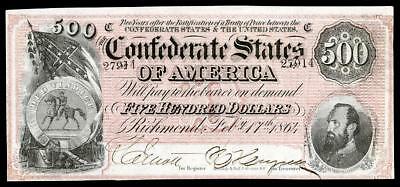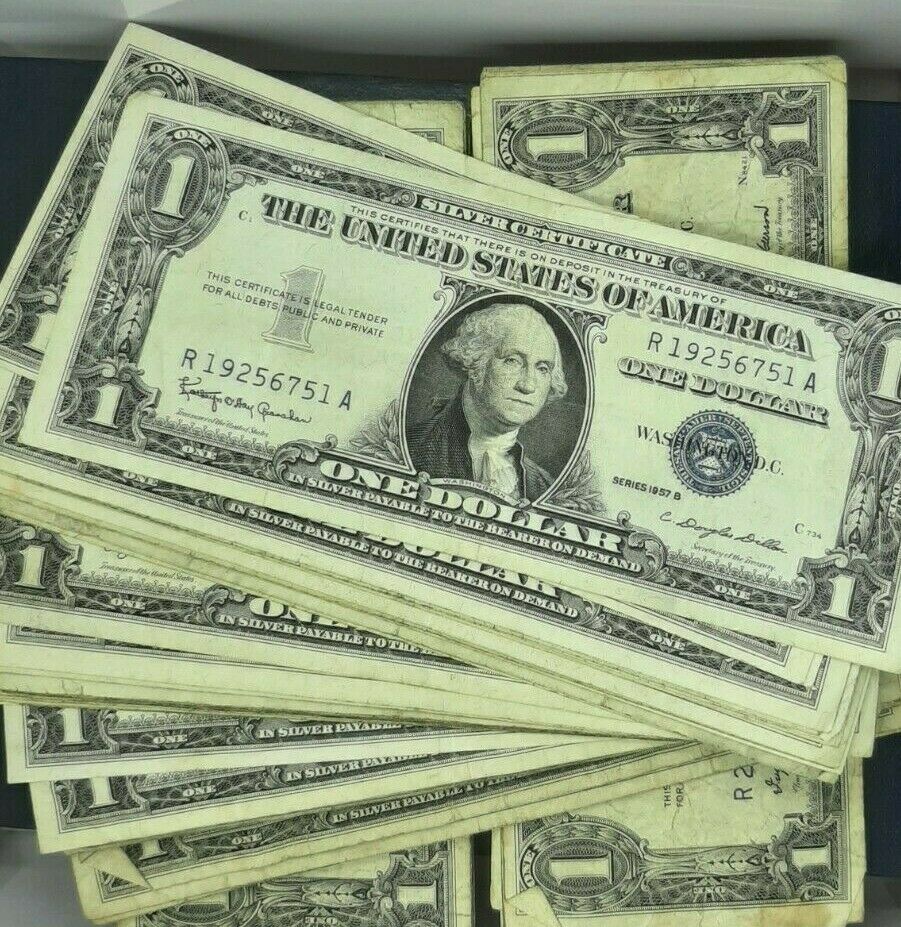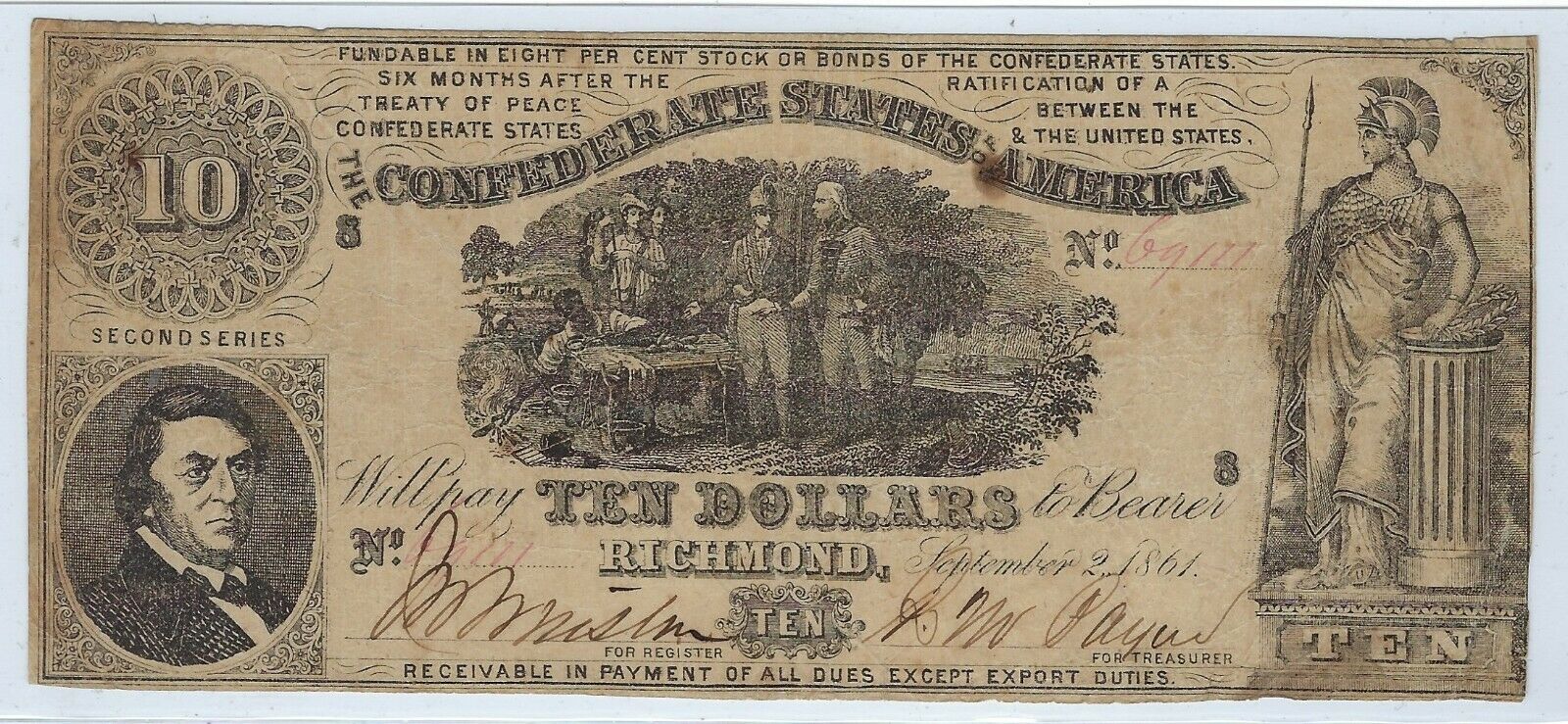-40%
T-33 PF-19 1861 Confederate Paper Money - PCGS-B Extremely Fine 40 Details
$ 528
- Description
- Size Guide
Description
T-33 PF-19. 1861 .00 CSA Currency.C. G. Memminger in the center. Minerva, right. Issued from March 13, 1862 through June 19, 1862. Keatinge & Ball engravers to the left (name reads from Bottom towards the top – facing in). Printed on paper watermarked FIVE.
Serial number 18120. Plen O.
PCGS Banknote Extremely Fine 40! Minor rust (just a small spot). Mounting remnants - not much visible on these either! Bright, bold yellow-green color! Most of frame line present! Rare grade.
Genuine.
This note is one of two of Leggett, Keatinge & Ball’s (later just Keatinge & Ball after Leggett was driven out of the business) high quality s printed in 1862. At right is a figure that represents Minerva, the Goddess of War. The bust of Christopher Gustavus Memminger, Secretary of the Treasury, graces the center of this note. Yellow-green or blue-green underprint. Receivable in payment for all dues except export dues and fundable in Confederate States stock bearing 8% interest six months after the ratification of a treaty of peace between the Confederate States and the United States.
This type comes on high quality bank note paper of several types – plain as well as watermarked with “FIVE”, CSA in block letters, and the very rare J Whatman watermark. There are a good number of very rare T-33 varieties – all of the CSA block letter paper and all of the Whatman notes. Further, many exhibit a plate state where “Va” at the end of the engraver’s name to the left is worn off the plate and didn’t print on the note (the “No Va” plate states). Finally, there is an error where “receivable” is misspelled “reoeivable” at the bottom of the note. The “FIVE” and “CSA” block letter watermarked versions of this misspelling are great rarities (and unlisted in Criswell despite Dr. Ball having at least one of them in his collection). In general, the Leggett, Keatinge & Ball varieties are tougher than the Keatinge & Ball equivalents, as Leggett left the business fairly early in the printing period for these notes.
This type is available in AU to Uncirculated, and they do appear from time to time. But they are rare and are tightly held. This note is generally not easily found in grades above Fine and even true Fines are getting tougher to find.
Most offered are VG and many have problems. This note circulated heavily as it was a low denomination note needed for smaller day-to-day purchases.
A note about 3rd party grading. PCGS and PMG do a good job putting a floor on quality within a grade range and have become proficient in detecting repairs (though occasionally they miss something, or see something that is not there, as we all can).
Notes housed in Net or Apparent holders have a wide range of quality from very nice (in rare cases may be nearly choice) to dogs with major problems, so each needs to be evaluated on their own.
However, PMG and PCGS focus on technical grading due to circulation and damage and do not have a mechanism for evaluating condition or eye appeal - whether a note is average, better than average, choice or gem for the grade based on its color, trim and margins. The exception to this are slabbed notes of New or Uncirculated grades to some degree. This is important as Very Fine, Extremely Fine or AU notes can have a wide range of values depending on these factors not reflected in the slab grade. A fully framed Confederate or obsolete note is worth considerably to a lot more than one that is trimmed into the margin for the same grade. Likewise, color is important. These factors can affect the value of a note by 50%, 2-1 or even 3-1, e.g., an AU 58 (PPQ or not) T-20 1861 CSA note trimmed into the margin is worth between 0 and 0. The same grade, AU 58 (PPQ or not), with a full frame and good color/inking is worth something like 0 to 00 depending on eye appeal. I will continue to use the terms plus for above average, choice and gem to mean varying degrees of superiority of condition and eye appeal of a note within a grade as documented in my book which is based on what collectors seek out and pay premiums for.
In coins, we’ve seen the third party graders add things like full bell lines, full head, full bands which reflected the market. I’d expect either the grading services or another party to do the same for paper money. If you are just buying the number on the holder for the best price, you may well be buying low end notes for the grade!
Pierre Fricke. Immediate Past President of the Society of Paper Money Collectors; Professional Numismatists Guild (PNG); Professional Currency Dealers Association (PCDA); ANA, EAC, etc...
BuyVintageMoney.
Author of the standard guide book to Confederate money - Collecting Confederate Money Field Edition 2014.
Free shipping and insurance.
eBay has announced that it will start to collect sales tax on behalf of sellers for items shipped to customers in Alabama (Jul 1), Connecticut (Apr 1), Iowa (Feb 1), Minnesota (Jan 1), New Jersey (May 1), Oklahoma (Jul 1), Pennsylvania (Jul 1), and Washington (Jan 1). Additional states are being added like Idaho and more than 20 others. This is the new internet tax out of the US Supreme Court Wayfair decision. Buyers are responsible for paying this sales tax.
See eBay information for list of states eBay charges this tax payable by buyers to eBay as part of eBay invoices -- https://www.ebay.com/help/selling/fees-credits-invoices/taxes-import-charges?id=4121#section4










